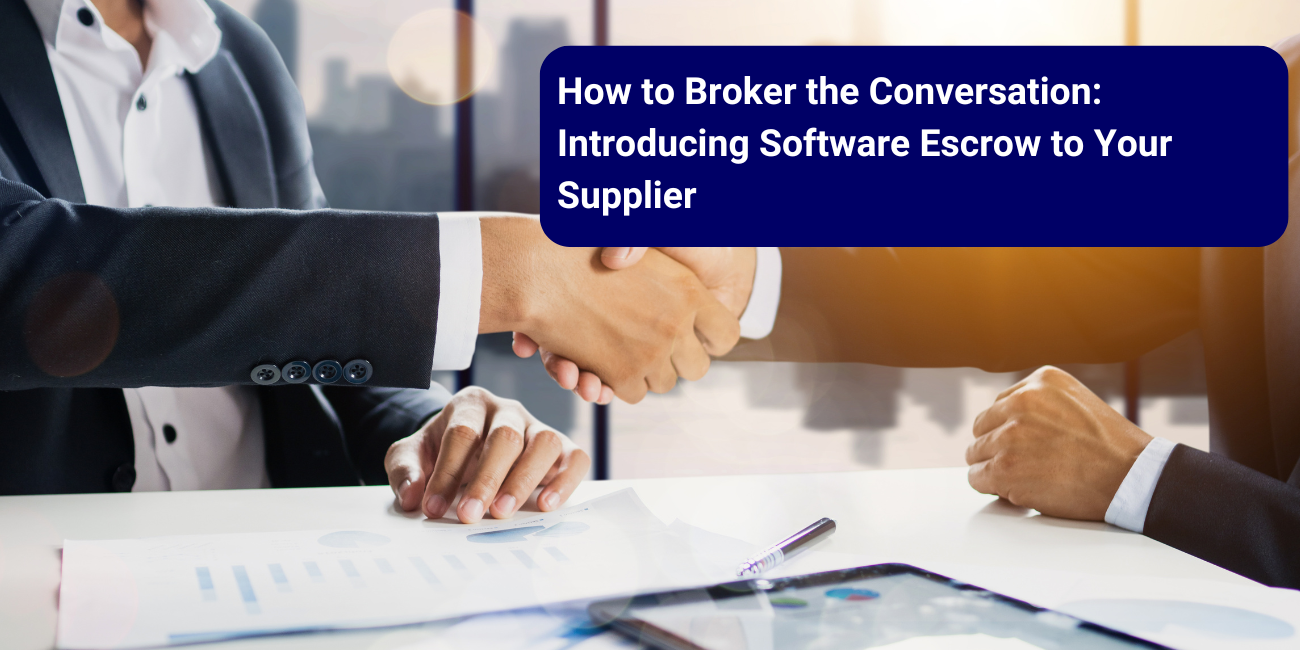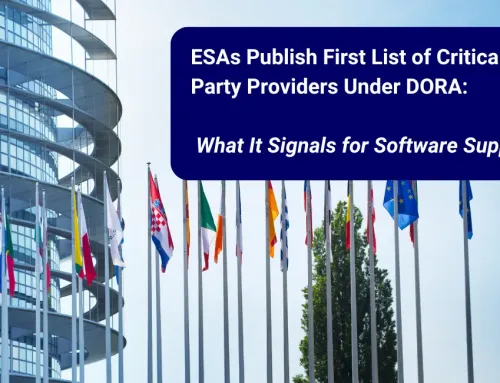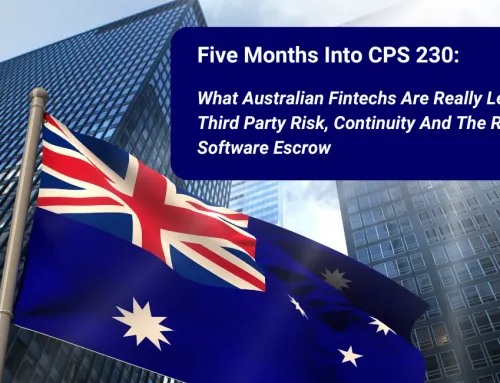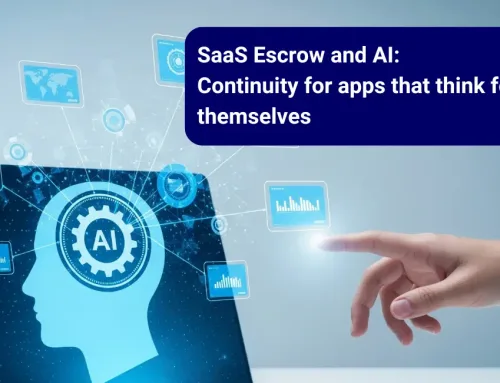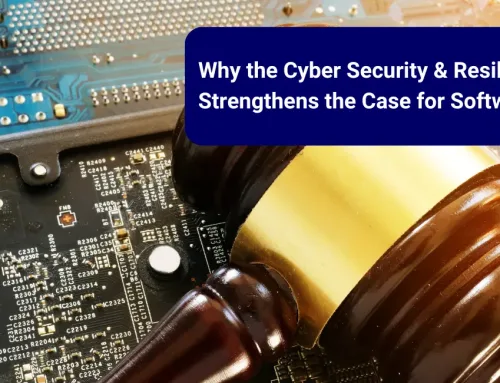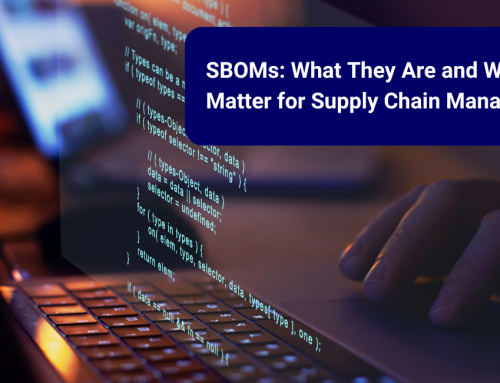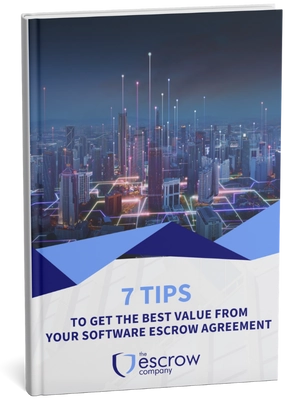How to Broker the Conversation: Introducing Software Escrow to Your Supplier
If your organisation relies on third-party software or SaaS to deliver essential services, any disruption to that software supplier, whether through insolvency, acquisition, or shifting priorities can quickly become a serious business continuity risk without a comprehensive software escrow agreement in place. But how do you introduce your supplier to Software Escrow without straining the relationship?
Regulators are increasingly recognising the challenges posed by risks like third-party failure. New frameworks like the Digital Operational Resilience Act (DORA) in the EU, the PRA’s SS2/21 in the UK, OSFI’s B10 in Canada, and CPS230 in Australia require regulated firms to have tested recovery and stressed exit plans in place for this as part of a broader operational resilience strategy.
As a result, many businesses are turning to software escrow as a practical risk mitigation solution.
Often, but not exclusively used with smaller, early-stage, or higher-risk vendors, software escrow or cloud escrow offers a formal continuity framework that can reduce the need for in-depth financial due diligence, replacing requests for sensitive details like financial runway or growth plans with a defined software escrow solution.
Your challenge as a Beneficiary
Once a risk or the need for software escrow is identified, the next hurdle for you to overcome as a beneficiary is: How do you bring your software or SaaS vendor into that conversation and introduce them to software escrow without straining the relationship?
After all, asking a key supplier to deposit their crown jewels such as source code with a third-party software escrow agent is a delicate situation.
This blog explores how you can approach those discussions, framing software escrow not as a burden, but as a mechanism that builds trust, strengthens the vendors’ position, and future-proofs relationships.
Beyond risk management, it can even create commercial opportunities for the vendor, turning escrow into a strategic advantage.
Here’s how to approach a software escrow conversation with your software vendor with clarity, empathy, and a shared sense of purpose.
Step 1: Frame the Conversation Around Risk and Resilience, Not Distrust
Early in the relationship, both parties are often assessing compatibility and exploring how to work together effectively while also, trusting that the other will deliver on their commitments.
The integration of a new digital solution is both mutually beneficial and a considerable undertaking. For the client to integrate a new vendor, upskill their internal resources and ultimately invest capital in new tech, is not to be downplayed even if they are relying on the vendor to deliver the tech.
As the client, you need guarantees the software will be available, regardless of what happens across your supply chain.
When Selling the Mutual Benefits of Software Escrow, First Impressions Matter
When bringing up software escrow with a software vendor, first impressions matter. Too often, software escrow is misunderstood as a sign of distrust or a legal “box ticking” exercise. In reality, it’s a mutual risk management mechanism and increasingly, a commercial necessity and a business enabler.
A good way to start the conversation might be:
“As part of our business continuity planning, we’re reviewing how we manage supplier risk across critical systems. We’d like to explore a software escrow agreement, as we see this relationship growing long-term and the system is vital to our operations. Building resilience into strategic partnerships is essential”
Presenting software escrow as part of a wider operational resilience framework demonstrates your seriousness and the significance you place on their solution.
Increasingly regulators are looking for alignment. When done effectively, software escrow can work in everyone’s favour. It can accelerate successful contract negotiations and project delivery.
The key is to shift all parties’ focus from any perceived judgment to a joint commitment to continuity and trust.
Step 2: Introduce software escrow to your supplier by highlighting the benefits
The key to winning buy-in when introducing your supplier to software escrow is demonstrating that software escrow isn’t just for the beneficiary, it also adds real, and tangible value for the software vendor. Here are some ways to position it:
“Software Escrow Accelerates Enterprise Sales”
For growing software and SaaS vendors, especially scaleups targeting regulated industries, having a software escrow agreement in place can be the difference between winning and losing a deal.
Many enterprise procurement teams have software escrow as a non-negotiable requirement. By offering it upfront, vendors can shorten sales cycles, reduce friction, and demonstrate enterprise-readiness.
As we have explored in this blog, software escrow is a practical way for scaleups to de-risk their product in the eyes of potential clients and build credibility during a due diligence process.
“Software Escrow Can Build Long-Term Client Trust“
Trust is a currency for suppliers. Our case study with a major digital payments provider shows how having a robust software escrow agreement in place reassured their institutional clients and strengthened commercial relationships. When a vendor proactively participates in a software escrow agreement, it signals maturity, stability, and professionalism.
“Software Escrow is a Proven and Secure Method of Adding Resilience”
Many vendors have concerns around handing over sensitive IP. At The Escrow Company, our agreements ensure the supplier retains full ownership of their code, with a release only happening under strict, predefined conditions.
These conditions can also be limited to certain locations, durations or other arrangements.
Our software escrow solutions are accredited with ISO 27001/27017using secure cloud-native deposit mechanisms which provides vendors peace of mind that their IP is safe, compared with cheaper software escrow solutions.
“Software Escrow Supports Compliance with Regulatory Trends”
As highlighted in our recent DORA blog, regulatory frameworks across Europe, the UK, and Asia-Pacific are pushing responsibility for third-party risk further down the supply chain. That means software vendors are now expected to support their clients’ resilience requirements—including tested recovery options like software escrow.
Step 3: Reassure Around Effort, Speed, and Simplicity
A common concern among vendors is that software escrow will involve legal red tape, burdensome setup, or ongoing manual processes. Perhaps being burnt years ago by having to periodically burn to physical media and other cumbersome approaches. But with The Escrow Company, the process is clear, simple and hassle-free.
We offer:
- Automated deposit processes that fit with cloud-native modern DevOps workflows such as direct deposits from git repositories and S3/Azure buckets.
- Flexible agreement terms that may be tailored to specific concerns and requirements of both the vendor and the beneficiary.
- A dedicated onboarding team to assist with the deposit process and to minimise internal overhead.
- Fast, pragmatic legal reviews that avoid weeks of back-and-forth.
A vendor-friendly way to introduce the topic would be:
“We’ve already spoken with The Escrow Company. They offer SaaS escrow services, with vast experience with cloud hosted applications, their escrow framework is designed to be supplier-friendly and commercially neutral. We’d be happy to get on a call together and talk through the best options and approach.”
This shows you’ve done your homework and removes the fear of complexity.
Step 4: Focus on Mutual Resilience when you introduce your supplier to software escrow
Ultimately, software escrow is not a one-sided safeguard. It’s a shared continuity strategy that protects both party’s interests.
Onboarding and due diligence can be a tense and challenging time for both the customer and the vendor. For example, the vendor may not yet have the level of documentation or accreditations expected by an enterprise company’s compliance and vendor management teams.
A client will often look for assurances to reduce risk or count a supplier out. Often considering longevity, financial status and size as key indicators for a vendor’s risk rating.
Conversely, scale-up’s are always looking to grow, but any growth investment that trains their cash flow position may be a red flag for clients signalling a potential risk.
If a business-critical application suddenly became unsupported due to a supplier’s insolvency, acquisition, or business model change, both the supplier and the client face significant exposure.
Software escrow offers a structured, fair, and secure contingency plan for what happens next.
That means less reputational risk, fewer emergency negotiations, and a clear recovery roadmap. In short: fewer unknowns.
Final Thought: It’s Not Just About Compliance, It’s About Confidence
Whether your vendor is a fast-growing fintech, an established SaaS platform, or a niche software developer, the principles are the same. When beneficiaries lead the software escrow conversation with collaboration, clarity, and commercial alignment, it becomes less of a legal obligation and more of a strategic advantage or a differentiator.
If your supplier needs support or has questions? We’re happy to help. At The Escrow Company, we regularly work closely with vendors to answer their questions, explain the software escrow process, and draft agreements that protect their IP while giving their clients the assurance they need.
Transparency. Trust. Technical Excellence guide every software escrow conversation we have. That’s the reason why vendors, who might feel hesitant at first, often end up becoming long-term partners.

